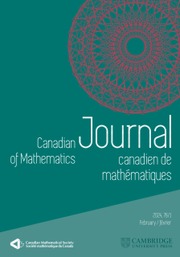Article contents
Eisenstein Series for Reductive Groups over Global Function Fields I.
The Cusp Form Case
Published online by Cambridge University Press: 20 November 2018
Extract
Let G be the Lie group SL(2, R) and Γ a discrete subgroup of arithmetic type. The homogeneous space Γ\G can be equipped with an invariant measure so that there is a Hilbert space of square integrable functions, denoted L 2(Γ\G), on which G acts by right translations. If Γ\Gis compact then this Hilbert space breaks up into a countable direct sum of irreducible representations of G, each occurring with finite multiplicity. Quite often however Γ\G is not compact, but of finite volume; in this case L 2(Γ\G) splits into a discrete spectrum L d 2 which behaves as if Γ\G were compact, and a continuous spectrum L c 2 which is described by the so called theory of Eisenstein series. These are generalized eigenfunctions of the Casimir operator of G, which are parametrized by a right half plane in C, and as such are analytic functions on this half-plane; in the course of describing the continuous spectrum L c 2 however, one analytically continues them to meromorphic functions over all of C, and shows them to satisfy functional equations.
Information
- Type
- Research Article
- Information
- Copyright
- Copyright © Canadian Mathematical Society 1982
References
- 9
- Cited by

